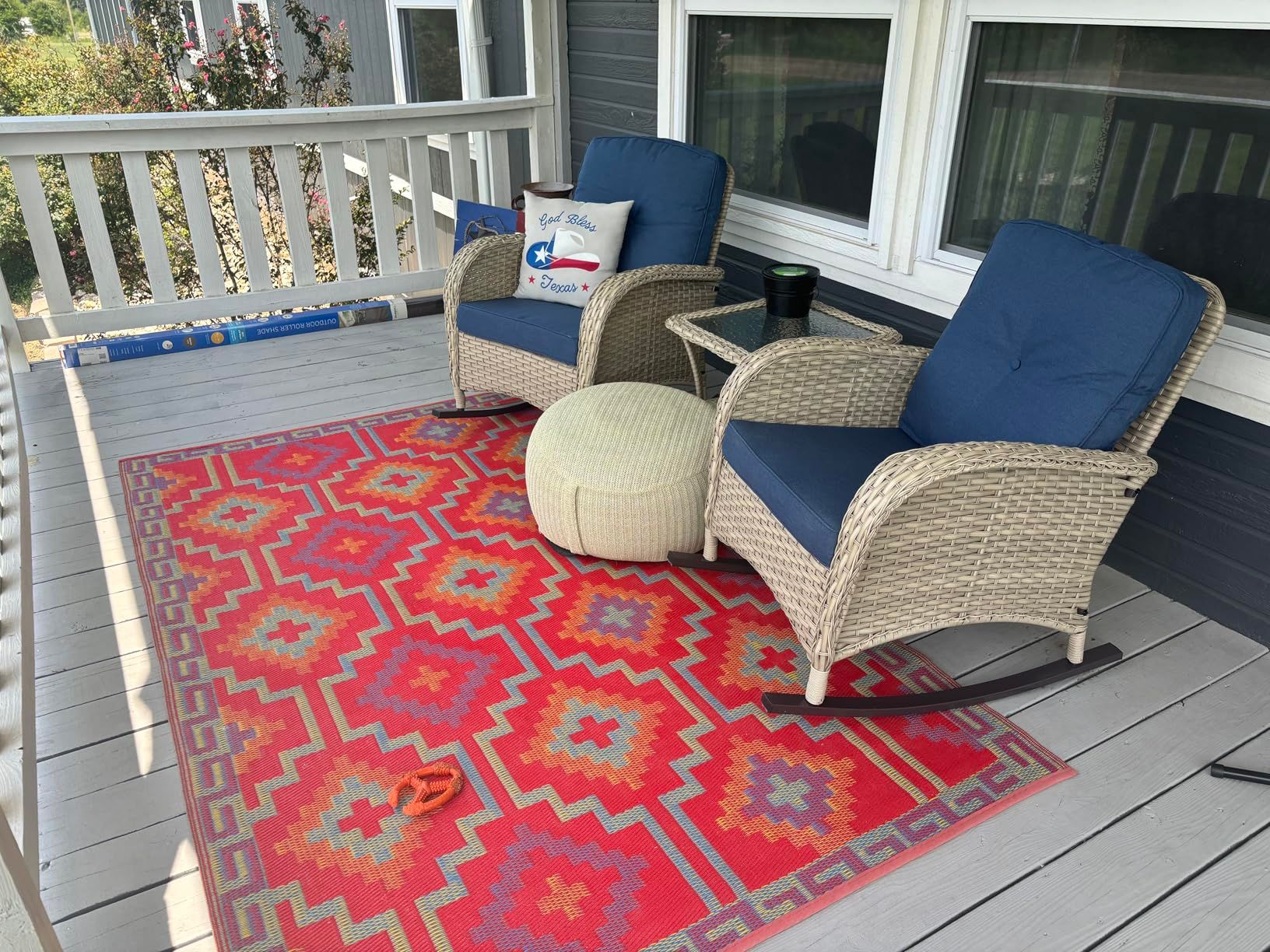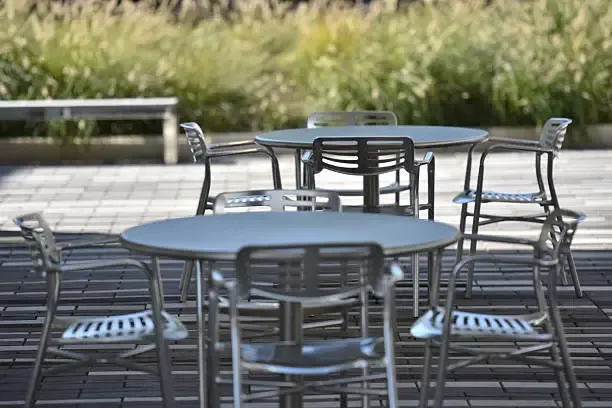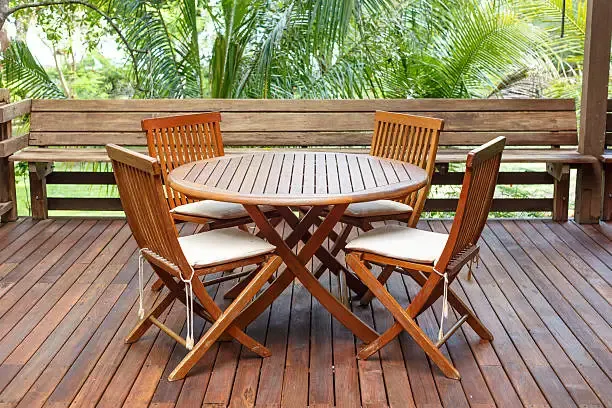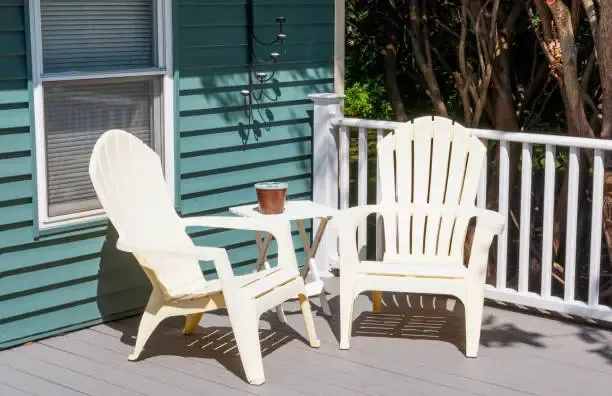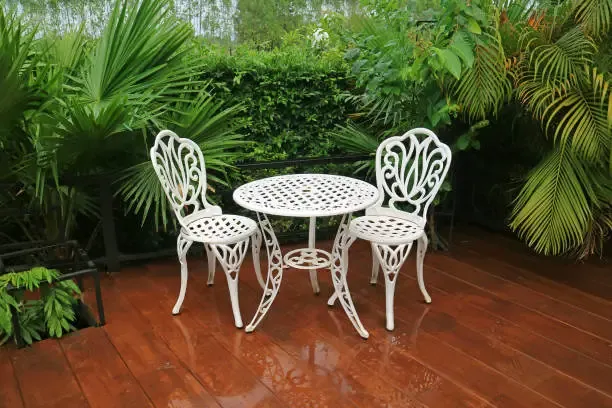
What Type of Patio Furniture is the Most Weather Resistant?
Share
When it comes to choosing the perfect patio furniture, one key consideration often stands out: how well can it withstand the elements? Whether you're dealing with scorching sun, torrential rain, or heavy snowfall, your outdoor furniture needs to be durable enough to stay looking good and remain functional. But with so many options on the market, from wood to metal to synthetic materials, which type is the most weather-resistant?
In this blog, we'll dive into the best types of weather-resistant patio furniture, exploring the pros and cons of various materials. This will help you make an informed decision to keep your outdoor space looking great all year round.
1. Wicker Patio Furniture: A Classic with a Modern Twist
Wicker has long been a favorite for outdoor furniture, but traditional natural wicker, made from rattan or other plant-based materials, can deteriorate quickly when exposed to the elements. Fortunately, today's modern wicker is made from synthetic materials like resin or polyethylene, which are far more durable.
Pros:
Weather Resistance: Synthetic wicker is highly resistant to rain, sun, and even snow. It won’t crack, peel, or fade over time, making it a great option for all climates.
Low Maintenance: Unlike natural wicker, which requires regular upkeep, synthetic wicker can be easily cleaned with a damp cloth and mild detergent.
Cons:
Heat Retention: Synthetic wicker can become quite hot if left in direct sunlight for long periods. Adding cushions can help mitigate this issue.
Price: High-quality synthetic wicker can be expensive, but it's an investment that pays off in longevity and durability.
2. Aluminum Patio Furniture: Lightweight and Rust-Free
Aluminum patio furniture is a popular choice due to its lightweight nature and rust-resistant properties. It's particularly well-suited for coastal areas where saltwater exposure is a concern.
Pros:
Rust Resistance: Aluminum doesn’t rust, so it’s an excellent choice for areas with high humidity or near the ocean.
Easy to Move: Its lightweight nature makes aluminum furniture easy to rearrange or store during off-seasons.
Low Maintenance: With a powder-coated finish, aluminum furniture is resistant to corrosion and requires minimal upkeep.
Cons:
Less Sturdy: While lightweight, aluminum can be less sturdy than other materials like steel or wrought iron. It may not hold up well in extremely windy conditions.
Heat Retention: Like wicker, aluminum can become hot to the touch when exposed to direct sunlight.
3. Teak Patio Furniture: The Ultimate in Durability
Teak is often hailed as the gold standard for outdoor furniture, and for good reason. This dense hardwood is naturally resistant to rot, insects, and the elements, making it a top choice for long-lasting outdoor furniture.
Pros:
Weather Resistance: Teak contains natural oils that make it resistant to water, sun, and pests. It can withstand all types of weather conditions without warping, cracking, or rotting.
Longevity: With proper care, teak furniture can last for decades, developing a beautiful silver-gray patina over time.
Cons:
Cost: Teak is one of the most expensive options on the market. However, its longevity makes it a worthwhile investment for those looking for furniture that will stand the test of time.
Maintenance: While teak is low maintenance compared to other woods, it does require periodic cleaning and oiling to maintain its color and prevent the buildup of mildew.
4. Plastic and Polywood Patio Furniture: Affordable and Low Maintenance
Plastic furniture has come a long way in recent years, with high-density polyethylene (HDPE) and other synthetic materials leading the charge. Polywood, a brand of HDPE lumber, mimics the look of wood but offers superior weather resistance.
Pros:
Weather Resistance: Plastic and Polywood furniture are impervious to moisture, resistant to UV rays, and won’t crack or splinter over time.
Eco-Friendly: Many plastic outdoor furniture products are made from recycled materials, making them an environmentally friendly option.
Low Maintenance: These materials are virtually maintenance-free, requiring only occasional cleaning with soap and water.
Cons:
Appearance: While more durable, plastic furniture may lack the aesthetic appeal of natural wood or metal. Some people find it looks less "high-end."
Weight: Lightweight plastic furniture can be easily blown over in strong winds.
5. Steel and Wrought Iron Patio Furniture: Strength and Elegance
For those who prioritize strength and durability, steel and wrought iron are excellent choices. These materials are known for their sturdiness and ability to withstand heavy use.
Pros:
Durability: Steel and wrought iron furniture can last for decades if properly maintained. They are extremely sturdy and can handle heavy winds and rough conditions.
Aesthetic Appeal: Both materials offer a classic, elegant look that complements various outdoor decor styles.
Cons:
Rust Potential: While steel and wrought iron are strong, they are susceptible to rust if not properly coated or treated. Regular maintenance is required to prevent rust from forming.
Weight: These materials are heavy, making them difficult to move. However, this also means they are less likely to tip over in strong winds.
Additional Features to Look for in Weather-Resistant Patio Furniture
Aside from the material, there are additional features that can enhance the weather-resistance of your outdoor furniture. These include:
UV Protection: Furniture with UV-resistant coatings helps prevent the fading and degradation caused by sun exposure. This is particularly important for colorful fabrics and painted metals.
Waterproof Coatings: If your furniture is exposed to heavy rains, ensure that it’s coated with waterproof finishes to prevent water damage. Some woods, like teak, naturally repel water, while others may need extra protection.
Weatherproof Cushions: Cushions with water-resistant fabrics and sealed zippers help protect against rain and moisture. Opt for cushions made from foam that’s designed to dry quickly to avoid mildew growth.
Rust-Resistant Coatings: For metal furniture, ensure the pieces are treated with rust-resistant coatings or finishes. This extends their life, even in wet or humid climates.
How to Maintain Weather-Resistant Patio Furniture
Even the most weather-resistant patio furniture requires some level of care to extend its life. Here are a few tips for maintaining your outdoor furniture:
Clean Regularly: Dirt, dust, and grime can accumulate on outdoor furniture over time. Clean your furniture at least once a month to keep it looking fresh. Use a gentle soap and water solution, avoiding harsh chemicals that could damage the surface.
Cover When Not in Use: While many materials are weather-resistant, covering your furniture when it's not in use can provide additional protection. This is particularly helpful in harsh weather conditions, such as heavy rain or snowstorms.
Store During Off-Season: If you live in an area with harsh winters, storing your outdoor furniture indoors or in a shed during the off-season helps prevent damage from snow, ice, and freezing temperatures.
Reapply Protective Coatings: For wooden or metal furniture, consider reapplying protective coatings or sealants once a year to keep the furniture in prime condition.
Check for Damage: Regularly inspect your furniture for signs of wear and tear, such as rust spots, cracks, or fading. Addressing these issues early will prevent further damage.
Conclusion
When it comes to selecting the most weather-resistant patio furniture, the choice largely depends on your specific needs, climate, and aesthetic preferences. Synthetic wicker and aluminum are great for lightweight, low-maintenance options, while teak offers unmatched durability for those willing to invest. Plastic and Polywood are perfect for those who want an eco-friendly and budget-conscious choice, and steel or wrought iron provide classic appeal with exceptional strength.
Ultimately, the best patio furniture for you is one that balances durability with style and comfort, ensuring your outdoor space remains a welcoming retreat, no matter the weather.

